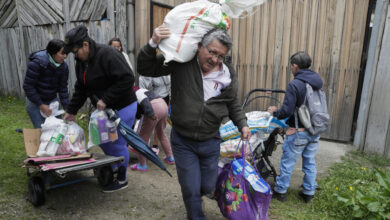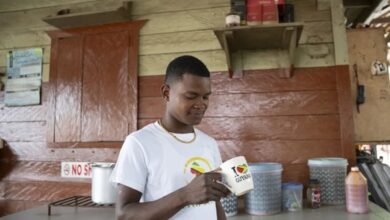Food insecurity in a new international system
In a year where humanity has been exposed to multiple threats, a fundamental concern of humanity returns: food.

The arrival of a global pandemic and the most drastic economic decline in contemporary history only expose the weakness of international institutions with food insecurity. / Photo: Unsplash
LatinAmerican Post | Jorge Francisco Vuelvas Lomeli
Listen to this article
Leer en español: Inseguridad alimentaria en un nuevo sistema internacional
The most important challenges facing the planet in the coming years will be: natural disasters, a consequence of the greenhouse effect, the lack of water and the political radicalization of society. The aforementioned challenges lead to a terrifying consequence for humanity: food insecurity at levels never seen before.
There are free-market theorists and intellectuals who expose to society a world awash in technological innovations, artificial intelligence, economic development and the end of poverty, promises that self-praise the work of political and economic power working together to stop an impending global catastrophe. However, the arrival of a global pandemic and the most drastic economic decline in contemporary history only expose the weakness of international institutions and the liberal market.
The liberalization of the food market and its impact on humanity.
The rapid technological and scientific advances, the commercial opening and globalization are elements that have not helped to completely eradicate hunger and have not guaranteed the stability of food security in humanity. By 2015, one of the Sustainable Development goals of the 2030 Agenda sought to put an end to this scourge; However, in 2020 the international context makes it almost impossible to achieve the goals of the aforementioned objective.
The same United Nations Development Program (UNDP) concluded that this year there were still 135 million severely hungry people in the world “mainly due to conflicts caused by human beings, climate change and economic recessions. The COVID-19 pandemic could now double that number and add an additional 130 million people who would be at risk of severe hunger by the end of 2020 ”.
Read also: What's next for climate change after COVID-19?
How are food security threats measured?
According to FAO, for a country to enjoy full food security it must meet four main dimensions:
- Physical availability of food
- Economic and physical access to food
- The use of food
- The time stability of the three dimensions
For each of the dimensions, the United Nations, the Inter-American Development Bank and other organizations have indicators that measure food insecurity, and although most of the indices give adverse effects to the African continent, most of the indicators of the stability make the Latin American region vulnerable.
This vulnerability is mismanaged by unstable governments in the region, as well as dependence on international markets that buy and sell goods in our countries.
Current situation of production systems
Current production systems are immersed in challenges that test their ability to overcome the new reality of the international market. In the first place, agriculture is engulfed in a system of domination by transnational corporations, which cause greater price volatility, and at the same time impede the growth and development of sustainable traditional agriculture.
Los campesinos y campesinas no dejan de cultivar la tierra en las crisis, para ellos no hay interrupciones porque son los que garantizan la seguridad alimentaria del país, es decir nuestra calidad de vida en la ciudades.#graciascampesino pic.twitter.com/iLbYeKgHfX
— CosechaDigital (@CosechaDigitalC) December 10, 2020
An example of the above can be seen in Mexico, since according to the Center for Studies for Sustainable Rural Development and Food Sovereignty of the Legislative Power, it determined that in 2018 a large part of the corn consumed in Mexico comes from the United States. This dependence is observed in a practical way as the Mexican nation positions itself as the largest buyer of corn in Washington, and the consumption of this internal grain is increasingly recurrent.
Peru is another example of food dependency, since according to FAO data, this country imports 87% of the wheat and 60% of all the corn it consumes; To this, we must add that the land use has not been managed in a timely manner in this South American nation, which is why it remains at the expense of speculation on international food prices.
How to deal with the threat?
A moral project and an ethical approach to the common good are not the most optimal strategy for improving food safety, since factors that are often not considered by the market in trade agreements and international rules must be taken into account. Among the main factors are: ideologies, cultures, religion, authoritarian political regimes and the birth of new powers that are inevitable in the international system (terrorism, drug trafficking and organized crime).
For this reason, the celebration of rules at the international level must have binding effects, under an international law perspective, which requires and establishes clear rules of fairness in the market and elimination of hunger, under a premise of the balance of power between nation-states. , transnational companies and multinational interests.
La mecanización agrícola sostenible puede reducir la pobreza y lograr la seguridad alimentaria al tiempo que mejora los medios de vida de las personas
¿Cómo podemos hacer que la mecanización en la agricultura sea más sostenible y accesible para los agricultores? pic.twitter.com/Cu5Ml3OKJ6
— FAO Américas (@FAOAmericas) December 13, 2020
Under this new international reality, the food trade can be strengthened by providing FAO with new powers that regulate the four dimensions of food security at the international level, in order to foresee a global crisis scenario in the event of environmental decline, war conflicts, pandemics and other events that threaten food security.
The international organization affirms that expanding the availability of food and effectively managing an agricultural policy is essential to maintain food stability. To achieve this, it is necessary to implement public policies that allocate public resources to agriculture and livestock; This will reduce dependence on foreign food trade and there is no vulnerability to changing prices in the international stock market.




